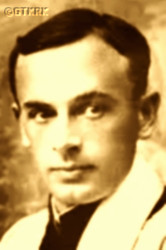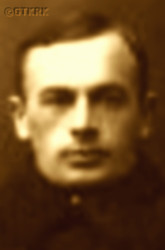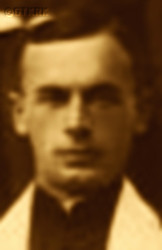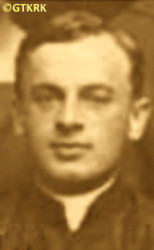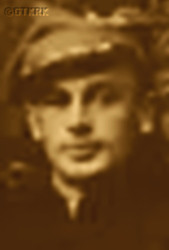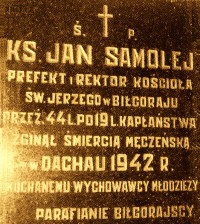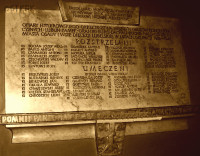Roman Catholic
St Sigismund parish
05-507 Słomczyn
85 Wiślana Str.
Konstancin deanery
Warsaw archdiocese, Poland
full list:
displayClick to display full list

searchClick to search full list by categories
wyświetlKliknij by wyświetlić pełną listę po polsku

szukajKliknij by przeszukać listę wg kategorii po polsku

Martyrology of the clergy — Poland
XX century (1914 – 1989)
personal data
surname
SAMOLEJ
forename(s)
John (pl. Jan)
forename(s)
versions/aliases
Adalbert (pl. Wojciech)
function
diocesan priest
creed
Latin (Roman Catholic) Church RCmore on
en.wikipedia.org
[access: 2014.09.21]
diocese / province
Lublin diocesemore on
pl.wikipedia.org
[access: 2013.05.19]
date and place
of death
12.08.1942

TA HartheimSchloss Hartheim „euthanasia” center
today: Alkoven, Eferding dist., Salzburg state, Austria
more on
en.wikipedia.org
[access: 2022.07.18]
alt. dates and places
of death
10.09.1942 (KL Dachau „death certificate” date)
details of death
After German and Russian invasion of Poland in 09.1939 and start of the World War II, after start of German occupation, for a time went into hiding in his family village Wilkołaz but returned to Biłgoraj.
Organised help to the wounded Polish soldiers held in Biłgoraj hospital.
There arrested by the Germans on 16.06.1940 (during so‐called «AB‐aktion», together with Fr Joseph Chmielewski, other vicar in Biłgoraj, among others).
Jailed in DL Zamosc (Rotunda) transit camp.
Next moved to Castle prison in Lublin.
From there on 30.06.1940 transported to KL Sachsenhausen concentration camp.
Next on 14.12.1940 moved to KL Dachau concentration camp.
Finally taken in a Germ. „Invalidentransport” (Eng. „Invalids' transport”) to TA Hartheim Euthanasia Center where perished murdered in a gas chamber.
According to the death certificate, prepared in KL Dachau, the „honest” otherwise German „medical doctors” and formalists — and at the same time, unrivaled fairy tale spinners — noted that the cause of death was Germ. „Versagen von Herz und Kreislauf, bei Linksseitiger Lungenentzündung” (Eng. „Heart and circulatory failure, with left‐sided pneumonia”).
prisoner camp's numbers
22535Click to display source page (KL DachauClick to display the description)
cause of death
extermination: gassing in a gas chamber
perpetrators
Germans
sites and events
TA HartheimClick to display the description, «Aktion T4»Click to display the description, KL DachauClick to display the description, KL SachsenhausenClick to display the description, Lublin (Castle)Click to display the description, DL ZamoscClick to display the description, «Intelligenzaktion»Click to display the description, GeneralgouvernementClick to display the description, Ribbentrop‐MolotovClick to display the description, Pius XI's encyclicalsClick to display the description
date and place
of birth
19.06.1898Birth certification on:
photos.szukajwarchiwach.gov.pl
[access: 2025.09.17]

Wilkołaztoday: Wilkołaz Pierwszy, Wilkołaz gm., Kraśnik pov., Lublin voiv., Poland
more on
en.wikipedia.org
[access: 2021.09.29]
parents
SAMOLEJ Adalbert
🞲 ?, ? — 🕆 ?, ?

KARAMON Marianne
🞲 ?, ? — 🕆 ?, ?
baptism
24.06.1904Birth certification on:
photos.szukajwarchiwach.gov.pl
[access: 2025.09.17]

Wilkołaztoday: Wilkołaz Pierwszy, Wilkołaz gm., Kraśnik pov., Lublin voiv., Poland
more on
en.wikipedia.org
[access: 2021.09.29]
St John the Baptist RC church
presbyter (holy orders)
ordination
17.06.1923

Pelplintoday: Pelplin gm., Tczew pov., Pomerania voiv., Poland
more on
en.wikipedia.org
[access: 2021.05.06]
St Barbara RC chapelmore on
pl.wikipedia.org
[access: 2021.12.19] (in Theological Seminary)
positions held
1929 – 1940
curatus/rector/expositus — Biłgorajtoday: Biłgoraj urban gm., Biłgoraj pov., Lublin voiv., Poland
more on
en.wikipedia.org
[access: 2020.12.03] ⋄ St George the Martyr RC church ⋄ Assumption of the Blessed Virgin Mary RC parish ⋄ Biłgorajtoday: Biłgoraj urban gm., Biłgoraj pov., Lublin voiv., Poland
more on
en.wikipedia.org
[access: 2020.12.03] RC deanery — also: prefect at Elementary School No 1, elementary school for girls and Craft and Industrial School; chaplain of the regional Council Hospital; chaplain of the branch of the Association of Polish Legionnaires; organizer and chaplain of the Rifle Association; initiator of the creation of the paintings „Miracle on the Vistula” and „Defense of Częstochowa” for his rectoral church (painted‐over during the German occupation)
1939
membership — Biłgorajtoday: Biłgoraj urban gm., Biłgoraj pov., Lublin voiv., Poland
more on
en.wikipedia.org
[access: 2020.12.03] ⋄ City Council
1927 – 1929
vicar — Zamośćtoday: Zamość gm., Zamość pov., Lublin voiv., Poland
more on
en.wikipedia.org
[access: 2021.06.07] ⋄ Our Lord's Resurrection and St Thomas the Apostle RC parish ⋄ Zamośćtoday: Zamość gm., Zamość pov., Lublin voiv., Poland
more on
en.wikipedia.org
[access: 2021.06.07] RC deanery — also: prefect of elementary schools
1927
curatus/rector/expositus — Hrubieszówtoday: Hrubieszów urban gm., Hrubieszów pov., Lublin voiv., Poland
more on
en.wikipedia.org
[access: 2021.08.20] ⋄ St Stanislav Kostka the Confessor RC church ⋄ St Nicholas the Bishop and Confessor RC parish ⋄ Hrubieszówtoday: Hrubieszów urban gm., Hrubieszów pov., Lublin voiv., Poland
more on
en.wikipedia.org
[access: 2021.08.20] RC deanery
1923 – 1927
curatus/rector/expositus — Grabowiectoday: Grabowiec gm., Zamość pov., Lublin voiv., Poland
more on
en.wikipedia.org
[access: 2021.08.20] ⋄ St Cajetan the Confessor RC church ⋄ St Nicholas the Bishop and Confessor RC parish ⋄ Hrubieszówtoday: Hrubieszów urban gm., Hrubieszów pov., Lublin voiv., Poland
more on
en.wikipedia.org
[access: 2021.08.20] RC deanery — also: prefect of elementary schools
1918 – 1923
student — Lublintoday: Lublin city pov., Lublin voiv., Poland
more on
en.wikipedia.org
[access: 2021.08.20] ⋄ philosophy and theology, Theological Seminary
others related
in death
CHMIELEWSKIClick to display biography Joseph, MILLERClick to display biography Eugene, NEBELSKIClick to display biography Adam, NOWAKClick to display biography Stanislav Zeno, OLKOWSKIClick to display biography Francis, PERCZAKClick to display biography Edmund, PIECHOWSKIClick to display biography Boleslav Bronislav, POTOCKIClick to display biography Mieczyslav, PRABUCKIClick to display biography Boleslav Rock, PYRKAClick to display biography Marian, PYTKOClick to display biography Henry, RADKOWSKIClick to display biography Ignatius, RADZKIClick to display biography Steven, ROMASClick to display biography Felix, RYSZTOGIClick to display biography Victor, RYTELClick to display biography Vaclav (Fr Viator), RZADKOWSKIClick to display biography Joseph Mieczyslav, STACHOWIAKClick to display biography Alexander Casimir, STĘPNIAKClick to display biography Joseph (Fr Florian), STRASZEWSKIClick to display biography Joseph, SULIMA–PRZYBOROWSKIClick to display biography John, SZWABIŃSKIClick to display biography Michael, TARGOŃSKIClick to display biography Eugene Matthias, TOCHOWICZClick to display biography Ignatius Marian, TOŁKACZClick to display biography Vaclav, TOMIŃSKIClick to display biography Anthony, WIERZBICKIClick to display biography Cornelius, WOJTASIKClick to display biography Vladislav Stanislav, ZAREMBAClick to display biography Joseph Bronislav, ZUSKEClick to display biography Stanislav Witold
sites and events
descriptions
TA Hartheim: From 05.1940, in the Germ. Tötungsanstalt (Eng. Killing/Euthanasia Center) TA Hartheim, at the Schloss Hartheim castle in Alkoven in Upper Austria, belonging to KL Mauthausen‐Gusen complex of concentration camps, as part of «Aktion T4» program, the Germans murdered victims — people mentally retarded and disabled — in gas chambers with carbon monoxide. Till 24.08.1941 and the formal end of the «Aktion T4» program, c. 18,000 people were murdered in TA Hartheim. In 04.1941 the program was extended to include concentration camp prisoners. Most, if not all, of the murdered clergy from the KL Dachau concentration camp were taken to TA Hartheim in the so‐called Germ. „Invalidentransport” (Eng. „transport of invalids”), prisoners who were sick and, according to the Germans, „unable to work” (initially under the pretext of transfer to a better camp) — after the formal end of «Aktion T4» as part of the program codenamed «Aktion 14 f 13». It is estimated that at this stage — until 11.12.1944 — c. 12,000 prisoners were gassed at TA Hartheim.
Note: The dates of death of victims murdered in Schloss Hartheim indicated in the „White Book” are the dates of deportations from the last concentration camp the victims where held in. The real dates of death are unknown — apart from c. 49 priests whose names were included in the niem. „Invalidentransports”, but who did not arrive at TA Hartheim. Prob. perished on the day of transport, somewhere between KL Dachau and Munich, and their bodies were thrown out of the transport and cremated in Munich. The investigation conducted by Polish Institute of National Remembrance IPN concluded, that the other victims were murdered immediately upon arrival in Schloss Hartheim, bodies cremated and the ashes spread over local fields and into Danube river. In order to hide details of the genocide Germans falsified both dates of death (for instance those entered into KL Dachau concentration camp books, which are presented in „White Book” as alternative dates of death) and their causes. (more on: ipn.gov.plClick to attempt to display webpage
[access: 2019.05.30], en.wikipedia.orgClick to attempt to display webpage
[access: 2019.05.30])
«Aktion T4»: German state euthanasia program, systematic murder of people mentally retarded, chronically, mentally and neurologically ill — „elimination of live not worth living” (Germ. „Vernichtung von lebensunwertem Leben”). At a peak, in 1940‐1941, c. 70,000 people were murdered, including patients of psychiatric hospitals in German occupied Poland — German formalists noted then that, among others, „performing disinfection [i.e. gassing] of 70,273 people with a life expectancy of up to 10 years saved food in the amount of 141,775,573.80 Deutschmark”. From 04.1941 also mentally ill and „disabled” (i.e. unable to work) prisoners held in German concentration camps were included in the program — denoted then as «Aktion 14 f 13». C. 20,000 inmates were then murdered, including Polish Catholic priests held in KL Dachau concentration camp, who were murdered in Hartheim gas chambers. The other „regional extension” of «Aktion T4» was «Aktion Brandt» program during which Germans murdered chronically ill patients in order to make space for wounded soldiers. It is estimated that at least 30,000 were murdered in this program. (more on: en.wikipedia.orgClick to attempt to display webpage
[access: 2014.10.31])
KL Dachau: KL Dachau in German Bavaria, set up in 1933, became the main German Germ. Konzentrationslager (Eng. concentration camp) KL for Catholic priests and religious during World War II: On c. 09.11.1940, Reichsführer‐SS Heinrich Himmler, head of the SS, Gestapo and German police, as a result of the Vatican's intervention, decided to transfer all clergymen detained in various concentration camps to KL Dachau camp. The first major transports took place on 08.12.1940. In KL Dachau Germans held approx. 3,000 priests, including 1,800 Poles. The priests were forced to slave labor in the Germ. „Die Plantage” — the largest herb garden in Europe, managed by the genocidal SS, consisting of many greenhouses, laboratory buildings and arable land, where experiments with new natural medicines were conducted — for many hours, without breaks, without protective clothing, no food. They slaved in construction, e.g. of camp's crematorium. In the barracks ruled hunger, freezing cold in the winter and suffocating heat during the summer, especially acute in 1941‐1942. Prisoners suffered from bouts of illnesses, including tuberculosis. Many were victims of murderous „medical experiments” — in 11.1942 c. 20 were given phlegmon injections; in 07.1942 to 05.1944 c. 120 were used by for malaria experiments. More than 750 Polish clerics where murdered by the Germans, some brought to TA Hartheim euthanasia centre set up in Schloss Hartheim in Austria and murdered in gas chambers. At its peak KL Dachau concentration camps’ system had nearly 100 slave labour sub‐camps located throughout southern Germany and Austria. There were c. 32,000 documented deaths at the camp, and thousands perished without a trace. C. 10,000 of the 30,000 inmates were found sick at the time of liberation, on 29.04.1945, by the USA troops… (more on: www.kz-gedenkstaette-dachau.deClick to attempt to display webpage
[access: 2013.08.10], en.wikipedia.orgClick to attempt to display webpage
[access: 2016.05.30])
KL Sachsenhausen: In Germ. Konzentrationslager (Eng. concentration camp) KL Sachsenhausen, set up in the former Olympic village in 07.1936, hundreds of Polish priests were held in 1940, before being transported to KL Dachau. Some of them perished in KL Sachsenhausen. Murderous medical experiments on prisoners were carried out in the camp. In 1942‐1944 c. 140 prisoners slaved at manufacturing false British pounds, passports, visas, stamps and other documents. Other prisoners also had to do slave work, for Heinkel aircraft manufacturer, AEG and Siemens among others. On average c. 50,000 prisoners were held at any time. Altogether more than 200,000 inmates were in jailed in KL Sachsenhausen and its branched, out of which tens of thousands perished. Prior to Russian arrival mass evacuation was ordered by the Germans and c. 80,000 prisoners were marched west in so‐called „death marches” to other camps, i.e. KL Mauthausen‐Gusen and KL Bergen‐Belsen. The camp got liberated on 22.04.1945. After end of armed hostilities Germans set up there secret camp for German prisoners and „suspicious” Russian soldiers. (more on: en.wikipedia.orgClick to attempt to display webpage
[access: 2018.11.18])
Lublin (Castle): During World War II, the Germ. Gefängnis der Sicherheitspolizei und des Sicherheitsdienst Lublin (Eng. Police and Security Service SD Prison), through which c. 40,000‐80,000 Poles passed during the German occupation, mostly members of Polish clandestine independence organizations (part of the Polish Clandestine State), before being sent by the Germans to concentration camps. The inmates were held in inhumane conditions, in overcrowded cells — up to 3,000 were held at one time in the prison designed for 700 people — where they were starved, harassed, and disease was rampant. During interrogations were tortured. Many were murdered — the prison housed the genocidal Germ. Sondergericht (Eng. special court), which issued serial death sentences after a trial lasting several minutes. C. 2,200 perished during the investigation or in the prison; 4,500 were murdered in secret executions in the vicinity of Lublin. When the Russians were fast approached Lublin in 08.1944, c. 1,500 prisoners were sent to the KL Lublin concentration camp, where were murdered, and on 22.07.1944, after a few hours prior to escape, c. 300 remaining were murdered in the prison itself. After the expulsion of the Germans in 1944, the prison was first run by Russians, then UB, the Polish branch of the Russian NKVD, and 32,000‐33,000 soldiers of the Home Army AK, part of the Polish Clandestine State, and the National Armed Forces NSZ, fighting against the Russian occupation, were detained there (in similar conditions to the Germans — in 04.1945 c. 8,000 people were held in the prison) and tortured. C. 515 were sentenced to death and 333 were murdered. The prison began to be liquidated in 02.1954. (more on: en.wikipedia.orgClick to attempt to display webpage
[access: 2015.09.30])
DL Zamosc: Germ. „Gefangenen Durchgangslager Sicherheitspol Zamosc” (Eng. „Prisoner of War Transition Camp of the Security Police”) — German transit concentration camp, prison and remand center for the population of the Zamość region (including many children), founded on 19.06.1940 in Rotunda, a former fortifications built by the Russian occupier in the 19th century century, in which 20 cells with an area of 20 m2 each were created around the courtyard. Initially, it held Poles arrested as part of the Germ. „Außerordentliche Befriedungsaktion” (Eng. „Extraordinary Pacific Action”), i.e. «AB‐aktion» — part of the wider genocidal extermination of the Polish intelligentsia operation, Germ. «Intelligenzaktion» — carried out in the Germ. Generalgouvernement (Eng. General Governorate). From there they were transported to KL Sachsenhausen and KL Dachau concentration camps. Later members of the Polish resistance movement (representatives of the Polish Underground State), among others, were held there. Those detained were beaten and tortured. Since 1942, the place of collective executions of many Poles — earlier, individual executions were only carried out. In total, the Germans held approximately 50,000 Poles in DL Zamosc and murdered approximately 6,000‐8,000 of them. In 1943, the Germans began digging up graves and burning the bodies, and their ashes were thrown into the river moat around the Rotunda building. (more on: pl.wikipedia.orgClick to attempt to display webpage
[access: 2013.10.05], muzeum-zamojskie.plClick to attempt to display webpage
[access: 2021.12.19])
«Intelligenzaktion»: German: «Intelligenzaktion» (English: „Intelligence Action”) — a German program of extermination of the Polish elite, mainly the intelligentsia and leadership layers, carried out from the beginning of the occupation in w 09.1939 to 04.1940, mainly in territories directly annexed to Germany, but also in the so‐called Germ. Generalgouvernement (Eng. General Governorate), where it was called «AB‐aktion». In the first phase, immediately after the beginning of the German occupation, during military operations carried out by the Germ. Wehrmacht (Eng. Armed Forces) and the genocidal units of the Germ. Einsatzgruppen (Eng. Operational Groups) of the Germ. Sicherheitspolizei (Eng. Security Police), i.e. SiPo, and Germ. Sicherheitsdienst des Reichsführers SS (Eng. Security Service of the Reichsführer SS), i.e. SD, organized by the Germ. Reichssicherheitshauptamt (Eng. Reich Main Security Office), i.e. RSHA, which followed the troops, carried out under the Germ. Unternehmen „Tannenberg” (Eng. Operation „Tannenberg”) — based on the so‐called Germ. Sonderfahndungsliste (Eng. Special Wanted Lists), i.e. proscription lists of Poles considered particularly dangerous to the Third Reich, prepared by the Zentralstelle II/P (Polen) unit of the German RSHA. Later, implemented by the German civilian occupation authorities and the genocidal unit of the Germ. Volksdeutscher Selbstschutz (Eng. Ethnic Germans Self‐Defense), whose members were Germ. Volksdeutsche (Eng. Ethnic Germans), i.e. representatives of the German minority in Poland. According to various sources, these lists, at the beginning of 09.1939, could have contained the details of 61,000—88,000 „dangerous” Poles — although these figures cannot be confirmed. In total, during this genocide, c. 50,000 teachers, Catholic priests, representatives of the landed gentry, freelancers, social and political activists, and retired military personnel were systematically and methodically murdered. Another 50,000 were sent to concentration camps, where only a negligible percentage survived. (more on: en.wikipedia.orgClick to attempt to display webpage
[access: 2014.10.04])
Generalgouvernement: After the Polish defeat in the 09.1939 campaign, which was the result of the Ribbentrop‐Molotov Pact and constituted the first stage of World War II, and the beginning of German occupation in part of Poland (in the other, eastern part of Poland, the Russian occupation began), the Germans divided the occupied Polish territory into five main regions. In two of them new German provinces were created, two other were incorporated into other provinces. However, the fifth part was treated separately, and in a political sense it was supposed to recreate the German idea from 1915 (during World War I, after the defeat of the Russians in the Battle of Gorlice in 05.1915) of creating a Polish enclave within Germany. Illegal in the sense of international law, i.e. Hague Convention, and public law, managed by the Germans according to separate laws — especially established for the Polish Germ. Untermenschen (Eng. subhumans) — till the Russian offensive in 1945 it constituted part of the Germ. Großdeutschland (Eng. Greater Germany). Till 31.07.1940 formally called Germ. Generalgouvernement für die besetzten polnischen Gebiete (Eng. General Government for the occupied Polish lands) — later simply Germ. Generalgouvernement (Eng. General Governorate), as in the years 1915‐1918. From 07.1941, i.e. after the German attack on 22.06.1941 against the erstwhile ally, the Russians, it also included the Galicia district, i.e. the Polish pre‐war south‐eastern voivodeships. A special criminal law was enacted and applied to Poles and Jews, allowing for the arbitrary administration of the death penalty regardless of the age of the „perpetrator”, and sanctioning the use of collective responsibility. After the end of the military conflict of the World War UU, the government of the Germ. Generalgouvernement was recognized as a criminal organization, and its leader, governor Hans Frank, guilty of war crimes and crimes against humanity and executed. (more on: en.wikipedia.orgClick to attempt to display webpage
[access: 2024.12.13])
Ribbentrop‐Molotov: Genocidal Russian‐German alliance pact between Russian leader Joseph Stalin and German leader Adolf Hitler signed on 23.08.1939 in Moscow by respective foreign ministers, Mr. Vyacheslav Molotov for Russia and Joachim von Ribbentrop for Germany. The pact sanctioned and was the direct cause of joint Russian and German invasion of Poland and the outbreak of the World War II in 09.1939. In a political sense, the pact was an attempt to restore the status quo ante before 1914, with one exception, namely the „commercial” exchange of the so‐called „Kingdom of Poland”, which in 1914 was part of the Russian Empire, fore Eastern Galicia (today's western Ukraine), in 1914 belonging to the Austro‐Hungarian Empire. Galicia, including Lviv, was to be taken over by the Russians, the „Kingdom of Poland” — under the name of the General Governorate — Germany. The resultant „war was one of the greatest calamities and dramas of humanity in history, for two atheistic and anti‐Christian ideologies — national and international socialism — rejected God and His fifth Decalogue commandment: Thou shall not kill!” (Abp Stanislav Gądecki, 01.09.2019). The decisions taken — backed up by the betrayal of the formal allies of Poland, France and Germany, which on 12.09.1939, at a joint conference in Abbeville, decided not to provide aid to attacked Poland and not to take military action against Germany (a clear breach of treaty obligations with Poland) — were on 28.09.1939 slightly altered and made more precise when a treaty on „German‐Russian boundaries and friendship” was agreed by the same murderous signatories. One of its findings was establishment of spheres of influence in Central and Eastern Europe and in consequence IV partition of Poland. In one of its secret annexes agreed, that: „the Signatories will not tolerate on its respective territories any Polish propaganda that affects the territory of the other Side. On their respective territories they will suppress all such propaganda and inform each other of the measures taken to accomplish it”. The agreements resulted in a series of meeting between two genocidal organization representing both sides — German Gestapo and Russian NKVD when coordination of efforts to exterminate Polish intelligentsia and Polish leading classes (in Germany called «Intelligenzaktion», in Russia took the form of Katyń massacres) where discussed. Resulted in deaths of hundreds of thousands of Polish intelligentsia, including thousands of priests presented here, and tens of millions of ordinary people,. The results of this Russian‐German pact lasted till 1989 and are still in evidence even today. (more on: en.wikipedia.orgClick to attempt to display webpage
[access: 2015.09.30])
Pius XI's encyclicals: Facing the creation of two totalitarian systems in Europe, which seemed to compete with each other, though there were more similarities than contradictions between them, Pope Pius XI issued in 03.1937 (within 5 days) two encyclicals. In the „Mit brennender Sorge” (Eng. „With Burning Concern”) published on 14.03.1938, condemned the national socialism prevailing in Germany. The Pope wrote: „Whoever, following the old Germanic‐pre‐Christian beliefs, puts various impersonal fate in the place of a personal God, denies the wisdom of God and Providence […], whoever exalts earthly values: race or nation, or state, or state system, representatives of state power or other fundamental values of human society, […] and makes them the highest standard of all values, including religious ones, and idolizes them, this one […] is far from true faith in God and from a worldview corresponding to such faith”. On 19.03.1937, published „Divini Redemptoris” (Eng. „Divine Redeemer”), in which criticized Russian communism, dialectical materialism and the class struggle theory. The Pope wrote: „Communism deprives man of freedom, and therefore the spiritual basis of all life norms. It deprives the human person of all his dignity and any moral support with which he could resist the onslaught of blind passions […] This is the new gospel that Bolshevik and godless communism preaches as a message of salvation and redemption of humanity”… Pius XI demanded that the established human law be subjected to the natural law of God , recommended the implementation of the ideal of a Christian state and society, and called on Catholics to resist. Two years later, National Socialist Germany and Communist Russia came together and started World War II. (more on: www.vatican.vaClick to attempt to display webpage
[access: 2023.05.28], www.vatican.vaClick to attempt to display webpage
[access: 2023.05.28])
sources
personal:
www.niedziela.plClick to attempt to display webpage
[access: 2012.12.28], stg.bilgoraj.com.plClick to attempt to display webpage
[access: 2018.02.15], photos.szukajwarchiwach.gov.plClick to attempt to display webpage
[access: 2025.09.17], www.ipgs.usClick to attempt to display webpage
[access: 2012.11.23], wnmpbilgoraj.4gr.plClick to attempt to display webpage
[access: 2013.05.19]
bibliographical:
„International Tracing Service (ITS), Bad Arolsen, GermanyClick to display source page”, Arolsen Archives
original images:
wnmpbilgoraj.4gr.plClick to attempt to display webpage
[access: 2013.05.19], www.bilgoraj.plClick to attempt to display webpage
[access: 2018.02.15], www.bilgoraj.plClick to attempt to display webpage
[access: 2018.02.15], www.rodzinakulik.euClick to attempt to display webpage
[access: 2019.10.13], stg.bilgoraj.com.plClick to attempt to display webpage
[access: 2018.02.15], stg.bilgoraj.com.plClick to attempt to display webpage
[access: 2018.02.15], www.gazetabilgoraj.plClick to attempt to display webpage
[access: 2014.01.16], www.miejscapamiecinarodowej.plClick to attempt to display webpage
[access: 2014.05.09]
LETTER to CUSTODIAN/ADMINISTRATOR
If you have an Email client on your communicator/computer — such as Mozilla Thunderbird, Windows Mail or Microsoft Outlook, described at WikipediaPatrz:
en.wikipedia.org, among others — try the link below, please:
LETTER to CUSTODIAN/ADMINISTRATORClick and try to call your own Email client
If however you do not run such a client or the above link is not active please send an email to the Custodian/Administrator using your account — in your customary email/correspondence engine — at the following address:

giving the following as the subject:
MARTYROLOGY: SAMOLEJ John
To return to the biography press below:
 Click to return to biography
Click to return to biography








